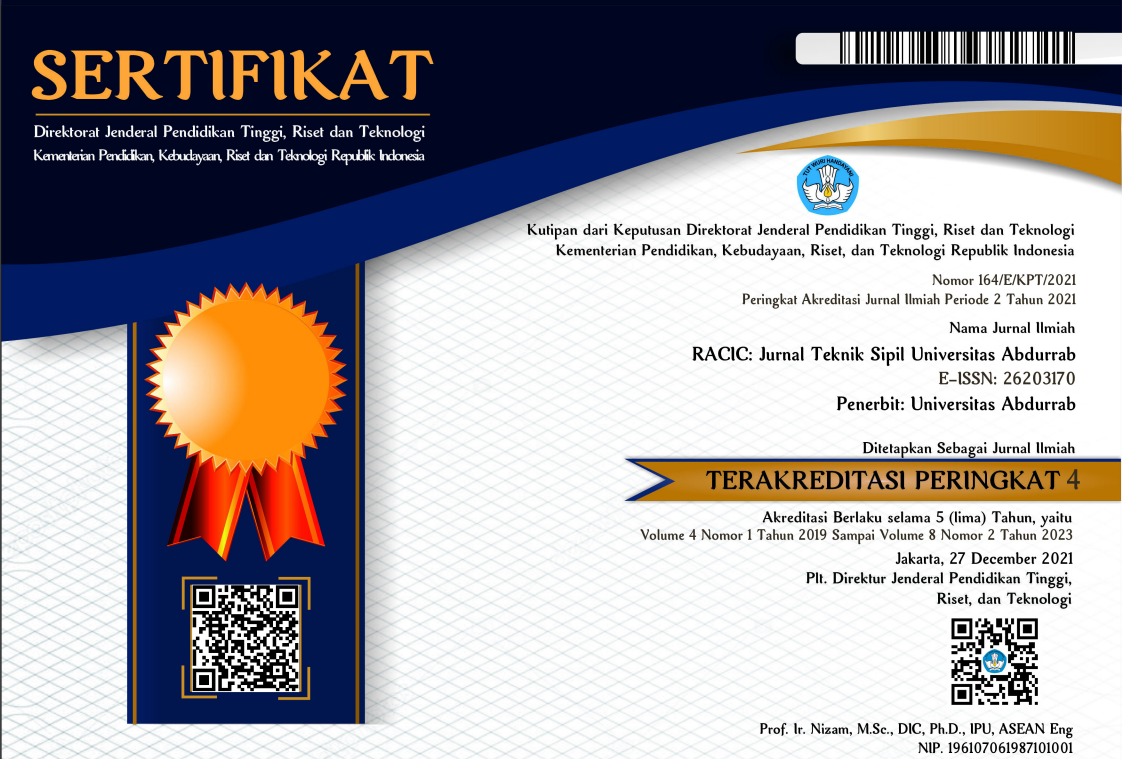PEMODELAN BANGKITAN PERGERAKAN (TRIP GENERATION) PADA KAWASAN SEKOLAH TERPADU (STUDI KASUS : JALAN SULTAN SYARIF QASIM, JALAN HANGTUAH, DAN JALAN DR. SUTOMO KOTA PEKANBARU)
PEMODELAN BANGKITAN PERGERAKAN (TRIP GENERATION) PADA KAWASAN SEKOLAH TERPADU (STUDI KASUS : JALAN SULTAN SYARIF QASIM, JALAN HANGTUAH, DAN JALAN DR. SUTOMO KOTA PEKANBARU)
DOI:
https://doi.org/10.36341/racic.v8i1.3071Keywords:
Generation, Attraction, Statistical Program (JASP), R²Abstract
The integrated school area is a place prone to traffic jams. The purpose of this study is to create a motion generation model. The method of data analysis and testing is linear regression analysis using a statistical program (JASP). Retrieval of data by counting the number of vehicles that deliver and pick up. Based on the results of calculations and analysis that has been done, the best model chosen for movement generation is Y1 = -44.826 + 0.241 X1 + 1.942 X2 + 7.294 X4 with an R² value of 0.996 and the best model chosen for movement attraction is Y2 = -60.461 + 0.235 X1 + 1.98 X2 + 7.92 X4 with an R² value of 0.995.
Downloads
References
Ghozali, I., (2017). Model Persamaan Struktural Konsep Dan Aplikasi Program AMOS 24, Penerbit Universitas Diponegoro, Semarang.
Rahmadani, F., (2015). “Analisa Permodelan Bangkitan Pergerakan Pada Tata Guna Lahan SMP di Kota Padangâ€, The 18th FSTPT International Symposium, STTD, Lampung,
Sarwono, J., 2006. Metode Penelitian Kuantitatif dan Kualitiatif, Penerbit Graha Ilmu, Yogyakarta.
Sugiyono, 2002. Statistik untuk Penelitian, Penerbit CV Alfabeta, Bandung.
Tamin Z. Ofyar, 2000. Perencanaan dan Permodelan Transportasi, Edisi kedua, Penerbit ITB, Bandung
Downloads
Published
Issue
Section
License
1. Copyright of all journal manuscripts is held by the RACIC : Rab Construction Research
2. Formal legal provisions to access digital articles of electronic journal are subject to the provision of the Creative Commons Attribution-ShareAlike license (CC BY-NC-SA), which means that RACIC : Rab Construction Research is rightful to keep, transfer media/format, manage in the form of databases, maintain, and publish articles.
3. Published manuscripts both printed and electronic are open access for educational, research, and library purposes. Additionally, the editorial board is not responsible for any violations of copyright law.
licensed under a Creative Commons Attribution-ShareAlike 4.0 International License.





